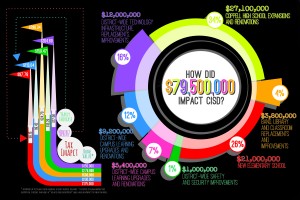By Shruthika Pochampally
Staff Writer
@shruthreddy
On May 11, 2013, a bond was passed by Coppell ISD voters after the proposal was created by a 44-member committee led by the Assistant Superintendent for Business and Support Service, Sid Grant, that initiated $79.5 million towards improvements throughout the district.
Tax increases, ranging from a $100 to $300 increase per year, city-wide construction and internal technological developments were approved that day, along with the building of a new school, Lee Elementary.

The increasing population in Coppell has called for most of these changes. The construction at the high school, for example, will provide an indoor facility for large school assemblies, as CHS’s population has spilled over capacity.
If there is not enough space for all of the students in the gym, it is hard to imagine that the classes and lunches at CHS are fit for the population as well. Some classes have a 30:1 student to teacher ratio, and the total student population is over 3,000. A multi-purpose gym seems a trivial solution for accommodation in comparison to hiring more teachers or expanding the size of the cafeteria. (The cafeteria and kitchen are being renovated, but not enlarged in size.)
Several coaches teach core subjects such as advanced math and physics courses and many teachers purchase bean bags and extra couches to seat their larger classes. Technological development is not as crucial when compared to having a sufficient and effective staff strength.
While Lee Elementary, Texas’s first net-zero school, moves CISD ahead in our technological ventures, national recognition for our technology should not be as much of a priority as accommodating all of the high school students. The new elementary school will again filter into one of the two high schools and will not will help the existing dilemma. The elementary schools are crowded as well, but the high school’s extent of overpopulation is far more concerning.
In retrospect, Lee Elementary seems like a temporary plan towards managing population when compared to a freshman center or possibly another high school campus in its place. Nearby schools such as Flower Mound High School have developed a freshman center within the past few years to accommodate their large population, and many would agree that Coppell would benefit by this as well.
Moreover, Coppell already has two indoor gyms along with a state-of-the-art outdoor stadium and fieldhouse; CHS already has a developed and funded athletic department. During the 2013-2014 school year, football received $268,643 from sales at the games according to Kelly Penny. Every football player on the team is asked to raise $400 a year, and the organization receives funds from its booster club and around $373,600 of budget money from the district, $19,500 of which is spent towards supplies such as helmets and shoulder pads.
With football being one of the most successful and populous athletic groups on campus, it is understandable that the organization generates a lot of spending money. CISD Athletics Director John Crawford said programs are given funds based off of the number of students who participate and that it depends on the diligence of the booster club and students to raise extra money.
Nonetheless, lesser known programs, such as debate and journalism fund for most of their budget independently.
The CHS debate team, led by Glenda Ferguson, qualified for the Tournament of Champions debate tournament for the three consecutive school years between 2007 to 2011, amongst other prestigious awards. The team consists of around 120 students and spends roughly $30,000 a year for tournaments, judges, substitutes, etc. The team receives approximately $10,000 a year from the district, so varsity debate students now have to pay entry fees of $300 on top of Pay-to-Play registration, and the booster club provides for a large portion of the funds required to compete.
The journalism department receives $1,777 from the district, and the academies organization, which includes STEM, receives $5,140 to be distributed amongst the three academies.
According to the district budget summary, the athletics department will receive a $100,000 more money than all of the co-curricular organizations at CHS combined.
Not all aspects of the bond are worrisome. One million dollars are allocated towards safety and security improvements throughout the district. With schools nationwide becoming a recurring location for terror attacks, security updates are almost necessary.
The bond has many perks as well as downsides, but those who may oppose it should make more of a proactive effort to participate in district and community decisions in the future. Though all of the organizations are well-established and successful, the distribution of budget could be better equalized to represent all of the many clubs and programs CHS has.








